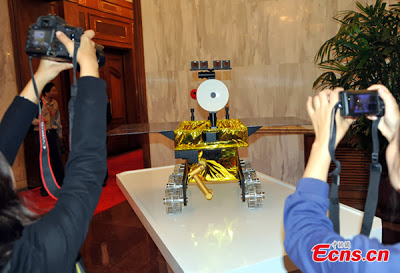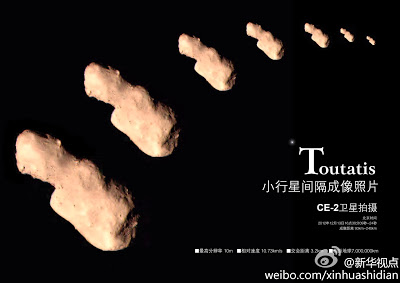Today, an official announcement was made to the media that the robot that the Chinese will land on the moon next month will be named "Youtu", which is the name of the rabbit from the moon

On the morning of July 20, 1969, the day Apollo 11 landed on the moon, the three astronauts received a headline report from the control center in Houston. The following passage appears in the transcript of the conversation, which is presented here in a free translation:
The control center: "Among the big headlines dealing with Apollo this morning, there is one that asks you to pay attention to a nice girl with a big rabbit. An ancient legend tells of a beautiful Chinese girl named Chang-O who has lived there for 4,000 years. It seems she was banished to the moon after stealing the immortality pill from her husband. You should also look for her companion, a large Chinese rabbit, which is easy to spot since it always stands on its hind legs in the shade of a cinnamon tree. The rabbit's name is not written."
Buzz Aldrin: "Okay, we'll pay attention to the rabbit girl." [Original transcript, The recording of the call starting at 1:23]
The legend of Chang'e and the jade rabbit living on the moon are well known in Chinese folklore, so it should not be surprising that the name of the Chinese space program for lunar exploration was named after Chang'e.

Chang'e 1 was the first Chinese spacecraft to fly to the moon. It operated starting in October 2007 for one year and four months in a 200-kilometer-high orbit around the moon, and carried out XNUMXD mapping of the surface at the same time as identifying chemical elements in the soil and collecting radiation data in the lunar environment.
Chang'e 2 was launched as a follow-up mission in October 2010. It was somewhat more sophisticated than its predecessor, and was put into an orbit that passes 100 km above the surface of the moon, at its highest point, and descends to a height of only 15 km at its lowest point. The spacecraft performed a thorough mapping of possible landing sites for the Chang'e 3 follow-on mission.
In June 2011, Chang'e 2 was transferred to the L2 Lagrange point, which is at a distance of one and a half million kilometers from the Earth in the direction opposite to the direction of the Sun. At this point, the gravitational forces of the Earth and the Sun are balanced, so that you can "park" a spacecraft there and keep it there with a very low investment of fuel.
In April 2012, Chang'e 2 was moved from the L2 point to an orbit that brought it in December of that year to a distance of only 3.2 kilometers from the asteroid Totatis. It is the only spacecraft that has passed close to this asteroid.
Chang'e 2 still continues to cruise in interplanetary space around the Sun, and is apparently still used to calibrate China's deep space network, to communicate with distant spacecraft.
The Chang'e 3 mission is currently being arranged for a December 1 launch. It is a robotic mission that is designed to make a soft landing on the moon. You should know that nothing has made a soft landing on the moon since the Soviet probe Luna on August 24, 1976!
From the lander of Chang-e 3 came a small robotic vehicle that could move away and turn around in close proximity.
The intended landing site is the sinus iridom, the bay of the rainbows. A large basaltic basin connecting to Mara Imbrium.
More interesting details about the moon in the record at this link.
The lander, which weighs about 1,200 kilograms, is equipped with means of communication, cameras and devices for examining the ground. In addition, a telescope for EUV (extreme ultraviolet) frequencies is installed on it, which will be the first astronomical observatory on the moon. The lander is planned to operate for three months with the help of a radioisotopic power generator (RTG), which will generate heat for her to survive the lunar night that lasts for two weeks, and electricity so that her systems can operate in any position of the sun.

Yuto is a rover, a robot on six wheels equipped with solar panels weighing about 140 kilograms. It is designed to survey the area around the lander, closely examine rocks, dig in the ground, identify chemical elements and even track with radar for the underground geological structures below the surface.
The jade rabbit is no ordinary rabbit. Ordinary rabbits do not live on the moon.
This mission is also a milestone in a larger plan, which will include the automatic return of soil samples from the Moon to Earth in a few years. In terms of intentions, it is possible that the Chinese intend to send a manned expedition to the moon by the end of the next decade.
Watch out for Chang'e 3. If there are no mishaps, it will do things that haven't been done in decades, and maybe drag the other space agencies to invest more in lunar exploration, and we'll all benefit.
Good luck!
Updates from the progress of the mission will appear on the Critical Mass Facebook page.
- to the original article on the website critical mass
- Read more: An article about choosing a name.
